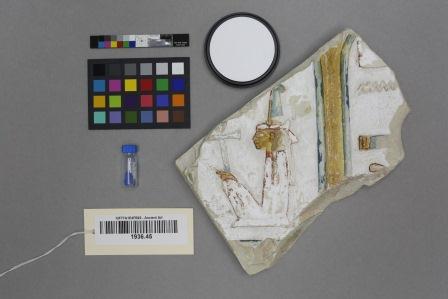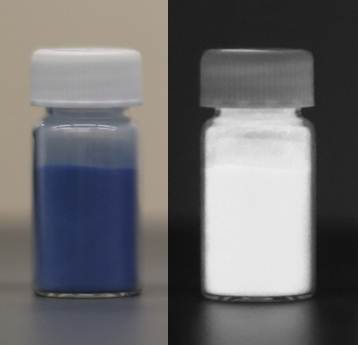
Ancient Pigment, New Discoveries: Egyptian Blue
By Megan Salas, IPCH Research Assistant
The pigment known as “Egyptian blue” (CaCuSi4O10)[1] is the oldest manmade pigment and it is the focus of a recent collaborative study among the Yale Institute for the Preservation of Cultural Heritage (IPCH), the Yale University Art Gallery (YUAG), and the Department of Near Eastern Languages and Civilizations.
There is evidence that Egyptian blue was used by the ancient Egyptians as early as 2600 BCE and became the primary blue colorant used in ancient Egypt through the Roman Periods of Egypt (ca. 30-395 CE).[2] Outside of Egypt, Egyptian blue appears in Mesopotamian inlays from the middle of the 3rd Millennium BCE.[3] Egyptian blue continued to be produced throughout the ancient Near East and Mediterranean through the 4th century CE and appears in the wall paintings at Pompeii.[4] By the 9th Century CE, the instructions to make Egyptian blue were lost or forgotten.[5] The pigment then fell out of use and production until the 1800s, when scientists determined its composition by studying known examples.[6]
The pigment is made by heating quartz, copper, alkali, and lime at temperatures up to 1000 ˚C over several hours, usually in more than one firing process.[7] The resulting material is ground into powder, the color of which depends on its coarseness.[8] Egyptian blue can be mixed with a binder to create paint; it is also often used as a glazing material.[9] Over time, Egyptian blue can discolor due to breakdown of the glass components of the material; in these cases, the bright turquoise color turns to a dark greenish black and the particles often crumble.[10]
Over the last few months, Egyptian blue has been a focus of study by Jens Stenger, IPCH Associate Conservation Scientist, Shiyanthi Thavapalan, Near Eastern Languages and Civilizations Ph.D. candidate, and Carol Snow, Deputy Chief Conservator and the Alan J. Dworsky Senior Conservator of Objects at YUAG. Thavapalan is studying Mesopotamian ideas of color. She is focusing on a pair of 9th-Century BCE Assyrian relief sculptures on view at the YUAG, which show no signs of blue color when viewed with the unaided eye.[11] Her larger goal is to reconstruct the color palette of Assyrian palaces originally located in places like present-day Nimrud, Iraq, where these reliefs came from. Thavapalan is especially interested in seeing if Egyptian blue could be detected on the Assyrian reliefs because blue pigments were harder to produce than others and thus their use indicates access to a certain level of advanced technology.
The unusual optical properties of Egyptian blue allow conservation scientists to detect the presence of minute quantities using imaging techniques. Egyptian blue fluoresces in the near infrared region of the electromagnetic spectrum when irradiated with visible light.[12] Infrared radiation (IR), which has a longer wavelength than visible light, is not visible to the unaided human eye.
Stenger has been using a customized digital camera (the camera’s IR-blocking filter has been removed) to image objects in the Yale University Art Gallery’s ancient art collection. Based upon the work of other conservation scientists, Stenger has adopted a relatively low-cost and user-friendly way of mapping Egyptian blue pigment grains on objects.[13] Before coming to Yale, Stenger began using a similar setup in 2013 at the Harvard Art Museums’ Straus Center for Conservation and Technical Studies and successfully identified Egyptian blue on several of the collection’s ancient objects.
The objects of interest are illuminated using intense light sources that lack an IR component or which are filtered to remove any IR components. In response to exciting radiation in the visible range, Egyptian blue pigment particles will emit IR radiation, causing them to glow bright white when viewed through the customized camera with an added filter that blocks visible light. This enables the camera to produce images in which visible-induced IR luminescence is recorded. It is possible to easily detect the presence of small amounts of Egyptian blue that cannot be seen with the unaided eye.
“You don’t know if Egyptian blue is on the relief. You have to do an experiment. It’s kind of like an archaeology dig—sometimes you find something, sometimes you don’t,” said Stenger.
The first object on which Stenger used this technique at Yale was an ancient Egyptian painted limestone relief depicting the goddess Maat from 1391-1353 BCE. Pigments were clearly visible; there were areas with a dark turquoise color that Stenger suspected to have been painted with Egyptian blue. These areas of the relief fluoresced and produced intense signal in the IR images, confirming the presence of Egyptian blue.
During several sessions in the YUAG Ancient Art gallery, Stenger, Thavapalan, and Snow have taken detailed images of both of the reliefs that are on view. These two reliefs, Human-headed Genie Watering Sacred Tree and Human Attendant Carrying a Bow, Arrows, and a Mace, have lost almost all traces of the original paint since they were produced in the 9th Century BCE. Additionally, these reliefs have been cleaned and restored since being removed from their original context by British excavators in the 1840s.
The IR imaging of the Assyrian reliefs revealed that there are traces of Egyptian blue in several locations. These particles appear concentrated in areas such as the beard of one of the figures and the whites of the eyes of both figures. Thus, it seems that Egyptian blue was mixed with other colors to produce composite effects like a cool, bluish white, or a very dark, blue-black beard.
“I didn’t expect to find any blue! The paint is so badly preserved that I wasn’t sure what we’d find,” said Thavapalan.
According to Snow, studies like this one have deep impacts on conservation practice around the world. Work like this emphasizes the importance of minimally invasive and nondestructive analytical and treatment practices in order to preserve what trace amounts of pigment may remain on ancient sculpture. This technique has the potential to transform ideas of ancient aesthetics and to shape the teaching of history of ancient art in the gallery and the classroom. Stenger and Snow hope to continue imaging other ancient objects from the Yale University Art Gallery.
“As a conservator what I find amazing about these reliefs is that they have any trace of pigment left at all,” said Snow. “We can rediscover how these ancient sculptures would have looked in antiquity.”

Vial containing Egyptian blue pigment. Left: visible light; right: visible light-induced infrared luminescence. (photo credit: Jens Stenger)

YUAG 1936.45 Visible light, painted limestone relief depicting Maat. Vial of Egyptian blue pigment on the left. (photo credit: Jens Stenger)

YUAG 1936.45 Visible light-induced IR luminescence, painted limestone relief depicting Maat. Vial of Egyptian blue pigment on the left. (photo credit: Jens Stenger, Megan Salas)

YUAG 1854.1. Visible light, Human-headed Genie Watering Sacred Tree. Almost no traces of pigment are visible with the unaided eye. (photo credit: Jens Stenger, Carol Snow, Shiyanthi Thavapalan)

YUAG 1854.1. Visible light-induced IR luminescence, Human-headed Genie Watering Sacred Tree. The areas that glow bright white contain Egyptian blue. (photo credit: Jens Stenger, Carol Snow, Shiyanthi Thavapalan)
Bibliography
Accorsi, Gianluca, Giovanni Verri, Margherita Bolognesi, Nicola Armaroli, Catia Clementi, Costanza Miliani, and Aldo Romani. “The exceptional near-infrared luminescence properties of cuprorivaite (Egyptian blue).” Chemical Communications 23 (2009):3392-3394. Accessed October 21, 2011. doi: 10.1039/B902563D.
Hatton, G.D., A.J. Shortland, and M.S. Tite. “The production technology of Egyptian blue and green frits from the second millennium BC Egypt and Mesopotamia.” Journal of Archaeological Science 35 (2008): 1591-92. Accessed April 16, 2014. doi:10.1016/j.jas.2007.11.008.
Lee, Lorna and Stephen Quirke. “Painting Materials,” in “Part I: Inorganic Materials.” In Ancient Egyptian Materials and Technology, edited by Paul T. Nicholson and Ian Shaw, 104-120. Cambridge: Cambridge UP, 2000.
Scott, David A. Copper and Bronze in Art: Corrosion, Colorants, Conservation. Los Angeles: Getty Conservation Institute, 2002.
Smith, Gregory D., Elizabeth Nunan, Claire Walker, and Dan Kushel. “Inexpensive, Near-Infrared Imaging of Artwork Using a Night-Vision Webcam for Chemistry-of-Art Courses.” Journal of Chemical Education 86, no. 12 (December 2009): 1382-1388.
Verri, Giovanni. “The spatially resolved characterization of Egyptian blue, Han blue and Han purple by photo-induced luminescence digital imaging.” Analytical and bioanalytical chemistry 394, no. 4 (June 2009):1011-1021. doi: 10.1007/s00216-009-2693-0.
[1] Lorna Lee and Stephen Quirke, “Painting Materials,” in “Part I: Inorganic Materials,” in Ancient Egyptian Materials and Technology, ed. Paul T. Nicholson and Ian Shaw (Cambridge: Cambridge UP, 2000), 109; David A. Scott, Copper and Bronze in Art: Corrosion, Colorants, Conservation (Los Angeles: Getty Conservation Institute, 2002), 259.
[2] Lorna Lee and Stephen Quirke, “Painting Materials,” in Ancient Egyptian Materials and Technology, 109; David A. Scott, Copper and Bronze in Art, 258; G.D. Hatton, A.J. Shortland, and M.S. Tite, “The production technology of Egyptian blue and green frits from the second millennium BC Egypt and Mesopotamia,” Journal of Archaeological Science 35 (2008): 1591-92, accessed April 16, 2014, doi:10.1016/j.jas.2007.11.008.
[3] Lee and Quirke, “Painting Materials,” 110.
[4] Lee and Quirke, “Painting Materials,” 111; Scott, Copper and Bronze in Art, 258.
[5] Scott, Copper and Bronze in Art, 258; Lee and Quirke, “Painting Materials,” 111.
[6] Scott, Copper and Bronze in Art, 258.
[7] Scott, Copper and Bronze in Art, 257, 261.
[8] Scott, Copper and Bronze in Art, 257.
[9] Scott, Copper and Bronze in Art, 257.
[10] Scott, Copper and Bronze in Art, 262.
[11] Upon close examination, there are traces of red and black pigments visible with on both Assyrian reliefs.
[12] Gianluca Accorsi et al., “The exceptional near-infrared luminescence properties of cuprorivaite (Egyptian blue),” Chemical Communications 23 (2009), accessed October 21, 2011, doi:10.1039/B902563D; Giovanni Verri, “The spatially resolved characterization of Egyptian blue, Han blue and Han purple by photo-induced luminescence digital imaging,” Analytical and bioanalytical chemistry 394, no. 4 (June 2009), doi: 10.1007/s00216-009-2693-0.
[13] Gregory D. Smith, et al., “Inexpensive, Near-Infrared Imaging of Artwork Using a Night-Vision Webcam for Chemistry-of-Art Courses,” Journal of Chemical Education 86, no. 12 (December 2009); Verri, “The spatially resolved characterization of Egyptian blue.”





